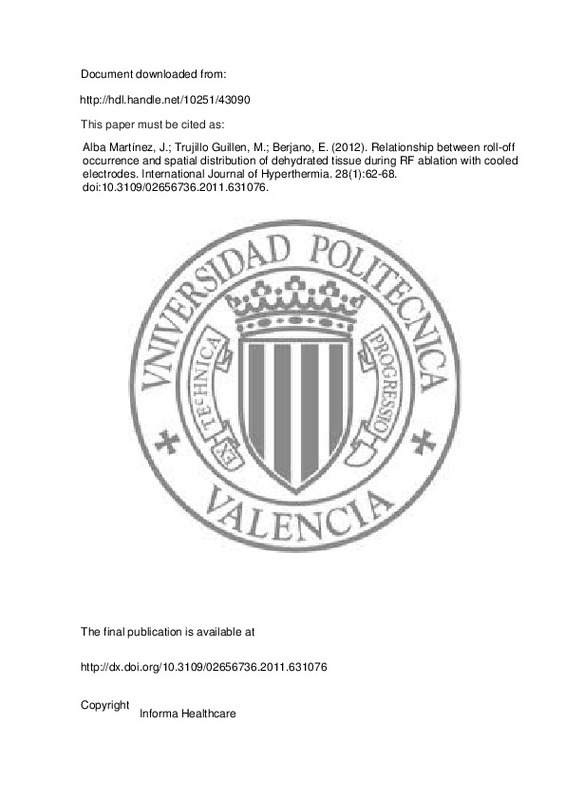Poon, R. T.-P., Fan, S.-T., Tsang, F. H.-F., & Wong, J. (2002). Locoregional Therapies for Hepatocellular Carcinoma: A Critical Review From the Surgeon’s Perspective. Annals of Surgery, 235(4), 466-486. doi:10.1097/00000658-200204000-00004
Solbiati, L., Livraghi, T., Goldberg, S. N., Ierace, T., Meloni, F., Dellanoce, M., … Gazelle, G. S. (2001). Percutaneous Radio-frequency Ablation of Hepatic Metastases from Colorectal Cancer: Long-term Results in 117 Patients. Radiology, 221(1), 159-166. doi:10.1148/radiol.2211001624
Ahmed, M., Brace, C. L., Lee, F. T., & Goldberg, S. N. (2011). Principles of and Advances in Percutaneous Ablation. Radiology, 258(2), 351-369. doi:10.1148/radiol.10081634
[+]
Poon, R. T.-P., Fan, S.-T., Tsang, F. H.-F., & Wong, J. (2002). Locoregional Therapies for Hepatocellular Carcinoma: A Critical Review From the Surgeon’s Perspective. Annals of Surgery, 235(4), 466-486. doi:10.1097/00000658-200204000-00004
Solbiati, L., Livraghi, T., Goldberg, S. N., Ierace, T., Meloni, F., Dellanoce, M., … Gazelle, G. S. (2001). Percutaneous Radio-frequency Ablation of Hepatic Metastases from Colorectal Cancer: Long-term Results in 117 Patients. Radiology, 221(1), 159-166. doi:10.1148/radiol.2211001624
Ahmed, M., Brace, C. L., Lee, F. T., & Goldberg, S. N. (2011). Principles of and Advances in Percutaneous Ablation. Radiology, 258(2), 351-369. doi:10.1148/radiol.10081634
Pereira, P. L., Trübenbach, J., Schenk, M., Subke, J., Kroeber, S., Schaefer, I., … Claussen, C. D. (2004). Radiofrequency Ablation: In Vivo Comparison of Four Commercially Available Devices in Pig Livers. Radiology, 232(2), 482-490. doi:10.1148/radiol.2322030184
Li, X., Zhang, L., Fan, W., Zhao, M., Wang, L., Tang, T., … Liu, Y. (2011). Comparison of microwave ablation and multipolar radiofrequency ablation, both using a pair of internally cooled interstitial applicators: Results inex vivoporcine livers. International Journal of Hyperthermia, 27(3), 240-248. doi:10.3109/02656736.2010.536967
Burdío, F., Tobajas, P., Quesada-Diez, R., Berjano, E., Navarro, A., Poves, I., & Grande, L. (2011). Distant Infusion of Saline May Enlarge Coagulation Volume During Radiofrequency Ablation of Liver Tissue Using Cool-tip Electrodes Without Impairing Predictability. American Journal of Roentgenology, 196(6), W837-W843. doi:10.2214/ajr.10.5202
Burdío, F., Navarro, A., Berjano, E. J., Burdío, J. M., Gonzalez, A., Güemes, A., … Grande, L. (2008). Radiofrequency hepatic ablation with internally cooled electrodes and hybrid applicators with distant saline infusion using an in vivo porcine model. European Journal of Surgical Oncology (EJSO), 34(7), 822-830. doi:10.1016/j.ejso.2007.09.029
Burdío, F., Berjano, E. J., Navarro, A., Burdío, J. M., Güemes, A., Grande, L., … de Gregorio, M. A. (2007). RF tumor ablation with internally cooled electrodes and saline infusion: what is the optimal location of the saline infusion? BioMedical Engineering OnLine, 6(1), 30. doi:10.1186/1475-925x-6-30
Haemmerich D, Mathematical modeling of impedance controlled radiofrequency tumor ablation and ex-vivo validation. Buenos Aires, Argentina: Proceedings of the 32nd Annual International Conference of the IEEE EMBS, 2010, pp. 1605–1608
Arata, M. A., Nisenbaum, H. L., Clark, T. W. I., & Soulen, M. C. (2001). Percutaneous Radiofrequency Ablation of Liver Tumors with the LeVeen Probe: Is Roll-off Predictive of Response? Journal of Vascular and Interventional Radiology, 12(4), 455-458. doi:10.1016/s1051-0443(07)61884-3
Haemmerich, D., Chachati, L., Wright, A. S., Mahvi, D. M., Lee, F. T., & Webster, J. G. (2003). Hepatic radiofrequency ablation with internally cooled probes: effect of coolant temperature on lesion size. IEEE Transactions on Biomedical Engineering, 50(4), 493-500. doi:10.1109/tbme.2003.809488
McGahan, J. P., Loh, S., Boschini, F. J., Paoli, E. E., Brock, J. M., Monsky, W. L., & Li, C.-S. (2010). Maximizing Parameters for Tissue Ablation by Using an Internally Cooled Electrode. Radiology, 256(2), 397-405. doi:10.1148/radiol.09090662
Berjano, E. J., Burdío, F., Navarro, A. C., Burdío, J. M., Güemes, A., Aldana, O., … Gregorio, M. A. de. (2006). Improved perfusion system for bipolar radiofrequency ablation of liver: preliminary findings from a computer modeling study. Physiological Measurement, 27(10), N55-N66. doi:10.1088/0967-3334/27/10/n03
Pätz, T., Kröger, T., & Preusser, T. (2009). Simulation of Radiofrequency Ablation Including Water Evaporation. World Congress on Medical Physics and Biomedical Engineering, September 7 - 12, 2009, Munich, Germany, 1287-1290. doi:10.1007/978-3-642-03882-2_341
Berjano, E. J. (2006). BioMedical Engineering OnLine, 5(1), 24. doi:10.1186/1475-925x-5-24
Jo, B., & Aksan, A. (2010). Prediction of the extent of thermal damage in the cornea during conductive keratoplasty. Journal of Thermal Biology, 35(4), 167-174. doi:10.1016/j.jtherbio.2010.02.004
Pearce, J., Panescu, D., & Thomsen, S. (2005). Simulation of diopter changes in radio frequency conductive keratoplasty in the cornea. Modelling in Medicine and Biology VI. doi:10.2495/bio050451
Abraham, J. P., & Sparrow, E. M. (2007). A thermal-ablation bioheat model including liquid-to-vapor phase change, pressure- and necrosis-dependent perfusion, and moisture-dependent properties. International Journal of Heat and Mass Transfer, 50(13-14), 2537-2544. doi:10.1016/j.ijheatmasstransfer.2006.11.045
[-]







![[Cerrado]](/themes/UPV/images/candado.png)


